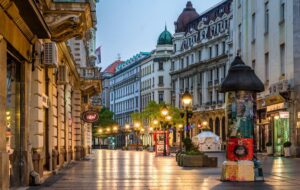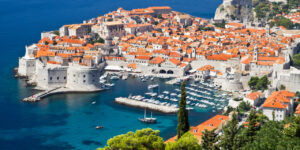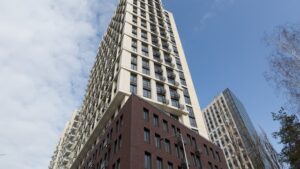
According to Serbian Economist, Serbia’s commercial real estate market will develop around Belgrade and expressway and railway corridors over the next decade, with the most dynamic growth expected in the office and industrial-logistics segments, according to the analytical report “Serbia real estate & construction outlook 2025–2035.”
According to the document, by 2035, Belgrade’s high-quality office stock could increase to 1–1.2 million square meters. The main demand will be provided by IT companies, engineering centers, the financial sector, and international service centers, while in Novi Sad and Niš, more compact clusters of office space focused on technology and research are forming.
The report identifies industrial and logistics real estate as the fastest-growing segment. Experts predict that by 2035, the total volume of modern warehouse space in Serbia could double or triple, with key logistics hubs forming in the Belgrade–Pancevo–Simanovci, Novi Sad–Ruma–Inđija, Kragujevac–Kraljevo, and Niš–Leskovac, as well as along international corridors X and XI.
Individual industry reviews confirm the stability of the industrial segment: according to consulting company iO Partners, in the first quarter of 2025, there were more than 1.2 million square meters of Class A warehouse space on the Serbian market, with vacancy rates remaining at around 6.5% and base rental rates at €5 per sq m per month, indicating a balanced supply and demand structure.
The report identifies potential delays in infrastructure projects, high financing costs, and political cycles that could affect the timing of major development programs as risks for commercial real estate. As strategic recommendations, investors are advised to focus on energy-efficient offices and industrial parks linked to international transport corridors, while the authorities are advised to accelerate the harmonisation of building standards with EU requirements and the digitisation of procedures for commercial projects.

Citizens of Ukraine and Russia are among the top ten foreign buyers of housing in Bulgaria in 2024–2025, according to a study by the Experts Club analytical center and data from the Bulgarian Real Estate Association.
According to the study, the top 10 countries whose citizens are most active in buying real estate in Bulgaria are: Great Britain, Germany, Greece, Israel, Romania, Turkey, Italy, Russia, Ukraine, and Poland.
Foreigners account for a significant share of transactions in the housing market. According to one international analytical resource, the number of foreign buyers of residential real estate in Bulgaria in 2024-2025 has increased by approximately 18%, and the overall market is showing steady price growth. According to local experts, the percentage of foreigners in some coastal projects may reach 30% of the total number of buyers.
Foreign buyers are most interested in properties on the Black Sea coast – in Varna, Burgas, and Nessebar – as well as in the mountain resorts of Bansko and Pamporovo, where real estate is considered both for personal use and as an investment for rental.
Analysts note that Ukrainians have firmly established themselves in the top 10 due to a combination of relocation and investment demand: some buyers view Bulgaria as a safe EU jurisdiction during the war, while others see it as an opportunity to earn income from renting out property in tourist regions.
The growth in foreign demand is supporting price increases: over the past year, the cost of housing in Bulgarian seaside resorts has risen by an average of 8-10%, and in Sofia by 7-10%.
At the same time, according to estimates by the European Commission and a number of analytical reviews, housing in Bulgaria in 2025 is overvalued by approximately 10-15% relative to fundamental indicators, but experts are not yet talking about a critical “bubble” in the market.
In the next 2–3 years, Experts Club analysts expect foreigners to keep showing interest in Bulgarian real estate, but with a change in the demand structure: they estimate that the share of buyers from the EU, Ukraine, and Israel will grow, while the role of Russian buyers in new deals may continue to decline amid sanctions and capital movement restrictions.
According to data from the National Statistical Institute of Bulgaria and international reviews, in the second half of 2024, housing prices in the country rose by 15% year-on-year and by 87% compared to 2015. At the same time, the average price per square meter in the country remains significantly lower than in most EU countries, making Bulgaria one of the most affordable real estate markets in the Union for foreign investors.
Russian citizens traditionally account for a significant share of owners, especially on the coast. According to Bulgarian sources, in the Burgas region alone, more than 5,200 properties owned by Russians are officially registered, while across the country as a whole, there are several tens of thousands of properties. At the same time, in recent years, the share of new purchases by Russians has been declining, and some of the properties are being put on the market and bought by Bulgarian and Western European buyers.
Source: https://expertsclub.eu/rynok-zhytla-bolgariyi-analiz-vid-experts-club/

Engineering and consulting company Sigma+ plans to attract $200 million in investments for real estate projects in Ukraine in 2026, according to the company’s press service. According to the report, the company currently has more than 500,000 square meters of real estate in its portfolio, of which 390,000 square meters are residential properties.
The company focuses on attracting international investments. The priority for the period 2027-2030 is the implementation of 1 million square meters of projects, both residential and commercial. In addition, Sigma+ plans to conduct an audit of four projects in the capital to further attract financing and complete construction, according to the press release.
Sigma+ is an engineering and consulting company that provides a full range of services, from market analysis and concept development to construction management, cost control, project auditing, sales, and marketing.
According to Opendatabot, the owner and ultimate beneficiary of Sigma Engineering Plus LLC (Kyiv), registered in December 2024, is the company’s CEO Anna Laevskaya.

During his speech at LUN Conference 2025, Oleksandr Ovcharenko, co-owner of Standard One, shared his vision of the development of the Ukrainian real estate market.
According to him, the number of projects will continue to decline, and developers should focus on creating products that provide predictable cash flow and build investor confidence.
“We will see a return of buyer and investor confidence. However, investors are becoming more demanding, looking for a balance between price, area, quality, product readiness and, above all, predictable profitability and payback,” said Ovcharenko.
He emphasized that the winner is not the developer who sells cheaply, but the one who transparently explains and communicates the value for which the investor should pay. After all, prices will continue to rise due to high production costs. Today, there is a certain imbalance in the market: when the cost of production is growing faster than the selling price. This forces many developers to temporarily suspend the launch of new projects and wait for better conditions.
Despite the difficult situation, the co-owner of Standard One sees the prospect of a gradual return of mass and institutional investors to the market.
“If a product that combines capitalization with a rental approach and is able to provide a stable cash flow is launched on the market, it attracts a lot of interest from investors. That is why Standard One was the first in Ukraine to research and implement projects in the build-to-rent format,” said Oleksandr Ovcharenko.
A separate topic for discussion was construction financing. According to Oleksandr, cross-financing is the first step to bankruptcy, so Standard One has abandoned this approach. The project uses its own financing system, in particular through installment programs, as buyers increasingly expect flexible and loyal terms.
This year, Standard One launched a new product on the market – S1 REIT. This is a proprietary investment instrument that diversifies sales sources by raising funds through collective investment institutions. It gives investors the opportunity to invest profitably in a liquid product or, having accumulated a certain number of certificates, to exchange them for an apartment. This expands investment opportunities for different categories of investors.
For reference:
Standard One (S1) is a full-cycle development company that has been developing the build-to-rent segment in Kyiv since 2016. The portfolio includes the completed S1 VDNH project and new buildings S1 Obolon, S1 Terminal, S1 Nyvky.

According to the Arvio report for the first quarter of 2025, 7.19% of all real estate transactions in Croatia were concluded by foreigners. The most active among them are:
· Slovenia — about 30.2% of transactions with foreigners
· Germany — approximately 21.1%
· Austria — about 10.4%
Buyers from Ukraine did not make it into the top 10 list of the most active real estate buyers in Croatia, but there are dozens of transactions involving Ukrainians purchasing real estate in Croatia.
At the same time, Ukrainian buyers are quite noticeable in the Balkans as a whole — in Montenegro, they ranked 11th among foreign real estate buyers, and in Bulgaria, they are consistently among the top 10 most active investors.
In recent years, the number of deals concluded by foreigners in Croatia has been declining:
· 2022 — ~ 13,344 deals
· 2023 — ~ 12,278
· 2024 — ~ 11,623 deals
Foreign buyers are particularly active in coastal regions such as Istria and Kvarner, as well as in areas popular for vacation and secondary housing. New apartments and houses that require minimal renovation or are immediately ready for occupancy or rental are in particularly high demand.
Real estate prices in some regions of Croatia are showing steady growth — about 10% per year. In coastal and tourist areas, average prices for new projects and apartments are significantly higher than the market average.
Given current trends, it is predicted that the share of foreign buyers in the total volume of transactions by the end of 2025 will remain within 8%, possibly declining slightly due to rising prices and housing affordability issues. Prices on the coast are expected to grow faster than average, driven by supply shortages, high tourist demand, and a focus on new properties.
There is also likely to be increased demand from Europeans in neighboring countries (Slovenia, Austria, Germany) and “returning diaspora.” As for purchases from countries outside the EU, the situation is less clear, and no significant flows have yet been recorded in public sources.

A decrease in supply on the residential real estate market in Kyiv and stable demand from buyers are maintaining the upward trend in prices for new buildings. By the end of the year, the cost per square meter will increase by 10-15%, the DIM group of companies told the Interfax-Ukraine agency.
“According to analysts at the DIM group of companies and industry observations, if the pace of the second half of the year does not fall below that of the first, the city will receive approximately 12-14 thousand new apartments by the end of the year, which is 15-20% less than last year. At the same time, limited supply amid stable demand will contribute to a further 10-15% increase in prices in the primary market by the end of the year,” the group said in a statement.
According to DIM, in the first half of 2025, the average price of new buildings increased by approximately 14% compared to the same period last year. Thus, , the average cost per square meter in new buildings is currently about $1,000/sq. m in the “economy” segment, $1,300/sq. m in the “comfort” segment, $2,200/sq. m in the ‘business’ segment, and $4,400/sq. m in the “premium” segment.
At the same time, the rate of increase in housing prices on the secondary market in the capital is slower: in the first half of 2025, prices rose by 8-10%, and the average cost per square meter on the secondary market is $2,000/sq. m.
According to Arseniy Nasikovsky, junior partner at DIM, the ability to move into ready-built housing is the main factor in choosing housing on the secondary market. However, a further reduction in the supply of new buildings in the event of a deterioration in the security situation will also shift the focus to secondary market properties.
“The choice between primary and secondary housing in 2025 will depend on the balance between readiness, risk, and the buyer’s financial capabilities. If the buyer values the ‘move in and live’ formula, they will choose secondary housing. New buildings offer a fundamentally different level of comfort, primarily a new level of security, which is very important in wartime, modern layouts, energy efficiency, and the availability of shelters and parking lots,” the expert explained.
According to DIM’s forecast, the restoration of new construction volumes to pre-war levels can be expected no earlier than the end of 2027. Today, there are only 140-145 residential complexes for sale on the capital’s market, which is a quarter less than before the war.
The portfolio of the development company DIM consists of real estate in Kyiv and the region with a total area of over 900,000 square meters. More than 3,600 apartments have been commissioned, and more than 356,000 square meters of residential and commercial space has been built. Six projects with a total area of more than 346,000 square meters are currently under construction.
Analysis, DIM, KYIV, REAL ESTATE, WHEAT